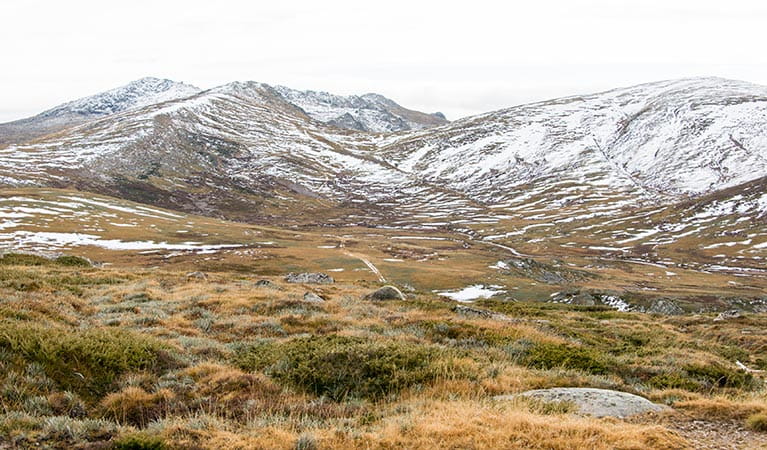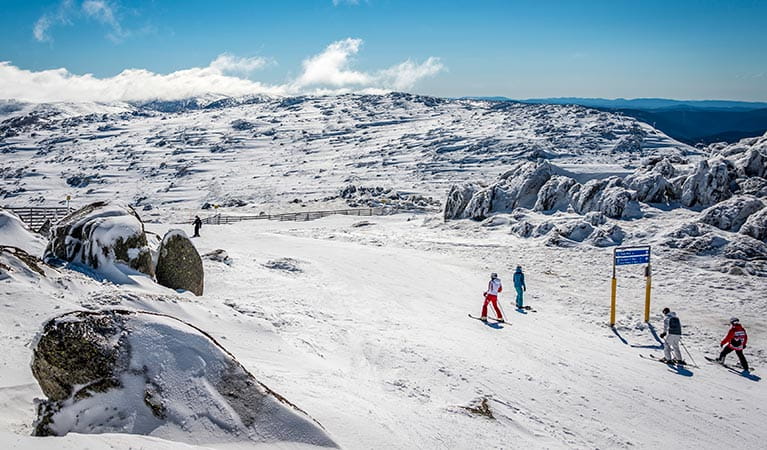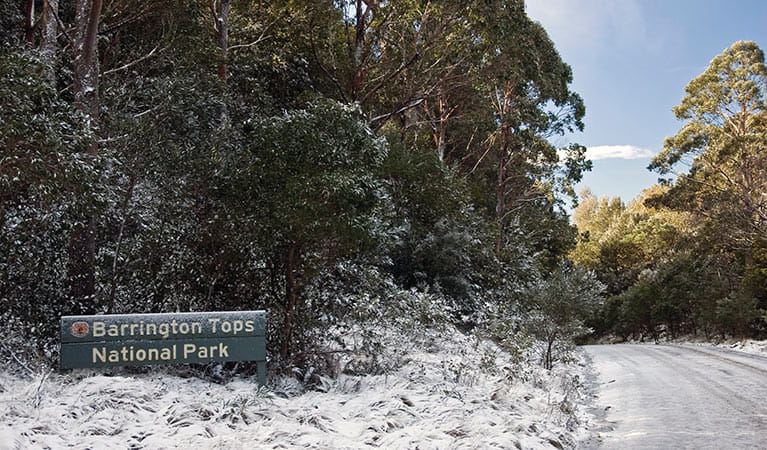Alpine safety
Alpine areas present special safety issues, particularly in winter. It’s important to be careful, knowledgeable and take the following safety precautions when visiting these areas.
Read more about Alpine safety
NSW Police and NSW National Parks staff are involved in search and rescue operations every year, many of these in alpine areas. These are often the result of visitors underestimating the conditions and sometimes overestimating their own capabilities.
Safety is your responsibility. With preparation, you’ll have an enjoyable and safe journey to the Australian Alps, high country and mountainous regions of NSW.
- Check if there are any park alerts or closures before you go.
- If you are inexperienced or are after an enhanced experience, consider using one of our licenced park Eco Pass guides.
- If you are experienced but the activity or conditions are unfamiliar (such as remote backcountry, icy or steep slope activities), consider using one of our Eco Pass guides for safety and experience.
- If your trip is planned for winter, consider snow conditions and avoid icy conditions unless you are appropriately experienced and equipped.
- Filling in a trip intention form is highly recommended for remote or backpack camping in all NSW national parks. This means camping away from bookable campgrounds. Filling in a trip intention form is not a campsite booking.
- Check the Australian Alps weather forecasts and the backcountry conditions for Kosciusko National Park. Talk to NPWS visitor centre staff about local park conditions so you can change your plans.
- If you're visiting other snow locations check the Bureau of Meteorology weather forecast before you go.
- Weather can change rapidly in alpine areas and conditions can be extreme, especially in winter. A storm can bring wind gusts of 150km per hour and up to 1 metre of snow over a 24hr period. Such storms can occur at any time of the year.
- Postpone your trip if bad weather is approaching. Bad weather includes an approaching low pressure system, cold front, strong wind warning or severe weather warning.
- Download the Emergency Plus app to your mobile or satellite phone, but remember that phones go flat very quickly in the cold.
- Travel with at least 3 people in your group. If there's an emergency, one of you can go for help while the other stays with the injured or sick person.
- At least 1 person in your group should be experienced and able to guide and help others.
- Make sure everyone has researched the trip and planned ahead. Each person must be confident with the itinerary and their individual ability.
- If you need help, call early. Delaying your call (especially after nightfall) can seriously restrict rescue efforts.
- Know your limits and stay within them. If you’re skiing or snowboarding, know how to stay in control. If you are venturing off-piste, you should be experienced because ungroomed surfaces can be unpredictable.
Telling your friends and family is crucial when heading into the Australian alpine environment. Give your trip details to family and friends who are not travelling with you. Tell them when you expect to return and let them know when you have returned.
For all remote trips, whether you are camping or taking a day trip, fill in a trip intention form and take a personal locator beacon.
- Bring plenty of drinking water to last your alpine adventure.
- Water supplies may be unreliable. Take enough water to be self-sufficient for several days, in case of emergencies.
- If you can't take enough water, you'll need to purify all stream water before drinking. Always boil water for at least 5mins or use treatment tablets, a filter or UV treatment.
- Collect water upstream from toilets, huts and campsites.
- You can melt snow, but melting snow can be very slow and energy consuming in a winter or alpine environment.
- If camping, take a tent and sleeping bag suitable for alpine conditions. In winter, make sure you have a 4-season tent.
- First aid kit and space blanket for emergencies.
- Layers of warm clothing and a waterproof outer layer.
- A warm hat, gloves and a spare pair of socks.
- Appropriate footwear for the conditions. Check out the local conditions. In spring, waterproof boots with good grip may be required to negotiate snow drifts.
- Plenty of water and food because it gives your body heat.
- Topographic map and compass (know how to use them) in addition to a GPS with spare batteries.
- Don’t rely on phone apps as phone batteries go flat very quickly in the cold. Be sure to have a back up power source if you are relying on your phone.
- If you're going to steep terrain or heading out in icy or forecast icy conditions, you will need appropriate equipment such as boot or ski crampons and some basic ice climbing equipment.
- Protect your skin from sunburn by using sunscreen and wearing sunglasses, protective clothing and a hat. UV is high and snow reflects a lot of sunlight, even on overcast days.
If you get lost or injured in alpine areas, stay where you are. If you move about, you'll be harder to find and you’ll use valuable energy.
Find a spot out of the wind and make a shelter. Leave something visible for people looking for you. Like an item of colourful clothing, skis or snowboard.
If you're in the Main Range of Kosciuszko National Park (above the treeline) area, do not drop down into the trees except for temporary shelter. The forest areas are dense and rugged and it can be almost impossible for helicopters to see people on the ground. If you do drop down into the trees, when the weather improves, climb back up into the alpine area where you’ll be more visible to searchers. Always leave visible markers leading searchers to your current location.
Hypothermia is a drop in normal body temperature. It can happen in cold, wet or windy conditions.
Tiredness and not enough food contribute to hypothermia. Apparent temperature is a combination of air temperature, relative humidity and wind speed.
Watch out for signs of hypothermia
A person with hypothermia might show these signs:
- Exhaustion
- Lagging behind
- Stumbling
- Slurred speech and a drunk appearance
- Cold to touch
- A slow and shallow pulse
- Difficult to reason with
How to treat hypothermia
- Treat the person immediately by giving them shelter and warmth with warm, dry clothes, sleeping bag or shared body warmth.
- Warm the person from the inside out – avoid excessive external heat such as placing the person near a fire or rubbing the skin.
- Give warm, sweet tea if the person is conscious.
- Let the person’s body temperature rise gradually and allow them to rest.
Frostbite
When the apparent temperature is around -30°C there is a serious danger of frostbite on exposed skin.
Avalanches and cornice collapse can occur at any time in Kosciuszko National Park during the winter months. They can be fatal. While they are not as common as North America or Europe, people have died in Australia from avalanches.
Knowing when an avalanche will occur is complex because they occur from snow accumulation patterns and weather conditions. A layer of fresh snow on top of an icy layer can increase avalanche risk significantly. However, rapidly melting snow can also increase snow instability. Temperature and wind affect the likelihood of an avalanche.
Unless you have avalanche experience or training, you should avoid steeper areas where there are no trees. Steep, narrow gullies as well as cornices on the tops of ridges — formed by snow accumulation in windy weather — also pose significant risks. Consider going with guide if you are inexperienced.
Refer to current back country conditions for current avalanche risk.
Snow conditions can vary greatly and certain conditions present significant risks, particularly on steep slopes. Always consider snow conditions as part of your overall assessment and planning for your trip.
Always consider ice risk. Avoid trips when conditions are extremely icy unless you are equipped and experienced for these conditions.
Soft snow conditions can significantly impact trip plans, making progress slow and crossing watercourses dangerous.
If you’re going off the beaten track, you should carry a tent suitable for alpine conditions.
Most visitors to Kosciuszko National Park will leave safely. But if you do get stuck in the snow and are unsure of rescue, you might need shelter. It can be a rewarding challenge to understand the basics of creating shelter in extreme conditions.
Huts
Kosciuszko National Park has over 80 historic huts, although some of these were burned in the 2020 bushfires. Huts are great for a hiking or skiing destination but are for emergency shelter only so make sure you carry a tent. Fill out the log book when you leave and please don’t leave any food or rubbish in the hut when you leave.
Snow caves
In extreme conditions, a snow cave may provide emergency shelter by maintaining a constant temperature inside just above 0°C. You'll need a snow shovel for construction and ski stock to create a ventilation hole. Keep the shovel inside the snow cave. Be aware that you'll get very wet during construction, which can take 2 to 4 hours and use up lots of energy. Always make your entrance lower than the living area to allow carbon dioxide to escape. It is strongly advised that you practice building a snow cave when you are not in an emergency situation.
Igloos
An igloo can give complete protection from extreme weather, but they are difficult and time consuming to build so only try this if you are experienced.
Ventilation
In all types of shelter, ventilation is essential and needs to be checked regularly, especially in windy or snowy weather. This is to prevent oxygen shortage or build up of carbon monoxide if you’re using a stove.
Remote camping needs careful planning, especially in alpine or sub-alpine conditions.
If you're going camping in Kosciuszko National Park's Main Range, read our need-to-know information for a safe and enjoyable remote camping adventure.
For all other locations, visit the campground or accommodation page to check safety information to ensure you have a safe and enjoyable camping adventure.
Driving in snow and ice needs special attention. Your safety is the highest priority. Read our tips for driving safely in snow and icy conditions.



